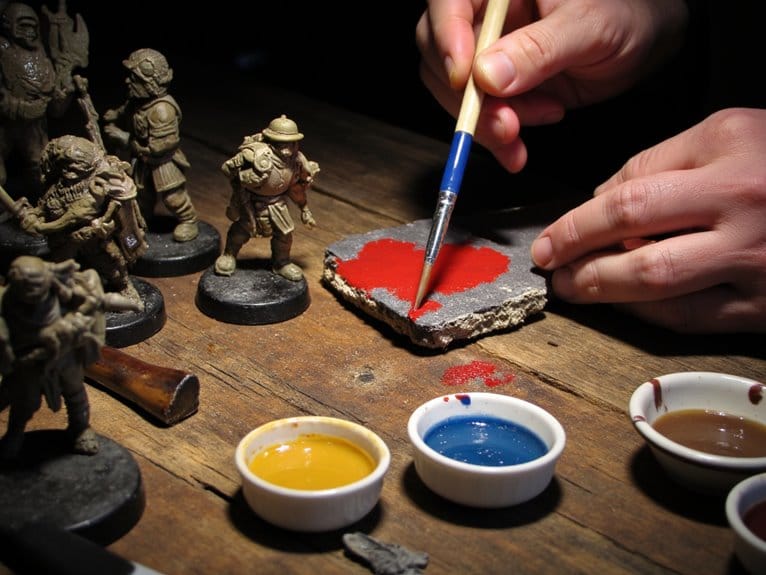We are supported by our audience. When you purchase through links on our site, we may earn an affiliate commission, at no extra cost for you. Learn more. Last update on 3rd July 2025 / Images from Amazon Product Advertising API.
Hey there, fellow miniature painting enthusiast! So, you've got your brushes and paints ready, but have you thought about the final touch that will truly make your miniatures shine?
That's where varnish comes in, my friend. It's like the cherry on top of a delicious sundae, the finishing touch that brings out the awesomeness of your masterpiece.
Today, I'm going to take you on a journey through the wonderful world of varnish, helping you understand the different types available and how to choose the perfect one for your miniatures. Trust me, by the end of this, you'll be equipped with all the knowledge you need to make the best decision for your tiny works of art.
Let's dive in, shall we?
Key Takeaways
- There are different types of varnish for miniature painting, including spray-on and brush-on varnish.
- Water-based varnish is non-toxic, quick-drying, and provides a protective and glossy finish.
- Oil-based varnish has a longer drying time, thicker consistency, and offers durability and protection for miniatures.
- The choice between matte and glossy varnish depends on the desired finish, with matte varnish enhancing realism and glossy varnish providing a shiny, reflective appearance.
Types of Varnish for Miniature Painting
What are the different types of varnish I can use for miniature painting?
When it comes to varnishing miniatures, there are two primary options: spray-on varnish and brush-on varnish.
Both have their pros and cons.
Spray-on varnish offers a quick and even application, making it ideal for large projects or when time is of the essence. However, it may be challenging to control the amount of varnish applied and can be wasteful.
On the other hand, brush-on varnish allows for greater precision and control over the application. It's perfect for smaller projects or when you want to achieve a specific finish.
Additionally, there are quick-drying varnish options available for time-sensitive projects. These varnishes dry rapidly, saving you valuable time and ensuring your miniatures are protected and ready for display or use in no time.
Water-Based Varnish Options
Moving on to the topic of water-based varnish options, I've found that they offer a great alternative for miniature painting projects. Water-based varnishes have several advantages over other types of varnishes, making them a popular choice among hobbyists and professionals alike.
One of the main advantages is that they're non-toxic and have low odor, making them safer to use in enclosed spaces. Additionally, water-based varnishes dry quickly and have excellent clarity, allowing the intricate details of the miniature to shine through.
To apply water-based varnish effectively, it's important to ensure that the surface is clean and free from dust and debris. Apply thin, even coats using a brush or airbrush, and allow each coat to dry completely before applying the next.
With water-based varnish, you can achieve a protective and glossy finish for your miniature painting projects.
Moving on to the subsequent section about 'oil-based varnish options',…
Oil-Based Varnish Options
As we delve into the realm of oil-based varnish options, it's important to consider their unique qualities and benefits for miniature painting projects.
Oil-based varnishes offer a longer drying time compared to water-based varnishes, allowing for more control during the application process. This slower drying time gives painters the freedom to work on their miniatures for an extended period without worrying about the varnish drying too quickly.
Additionally, oil-based varnishes tend to have a thicker consistency, which makes them ideal for protecting miniatures from damage and wear. When applying oil-based varnish, it's recommended to use a brush or airbrush to achieve an even and smooth finish.
It's important to note that oil-based varnishes require proper ventilation and safety precautions due to their solvent-based nature.
Matte Vs. Glossy Varnish: Which Is Right for You
Continuing from the previous subtopic, I prefer using a matte varnish for my miniature painting projects due to its unique qualities and benefits. Here are the pros and cons of using matte varnish for miniatures:
Pros:
- Matte varnish provides a non-reflective finish, which can enhance the realism of your miniatures.
- It reduces the shine on surfaces, making them appear more natural and textured.
- Matte varnish is great for creating weathered or worn-out effects on miniatures, adding depth and character to your models.
Cons:
- Matte varnish can slightly dull the colors of your miniatures, reducing their vibrancy.
- It may require multiple coats to achieve a smooth and even finish.
- Matte varnish isn't as durable as glossy varnish, and may be more prone to chipping or wearing off over time.
If you prefer a glossy finish for your miniatures, you can achieve it by using a gloss varnish as a final coat. This will give your models a shiny, reflective appearance while still protecting the paint underneath.
How Can I Choose the Right Varnish for Miniature Painting?
When choosing the right varnish for miniature painting, consider the type of finish you desire, whether matte, satin, or gloss. It’s important to understand varnish effectiveness explained; some varnishes are specifically formulated for protecting acrylic paints, while others work better with oil paints. Research and test different varnishes before making a decision.
Factors to Consider When Choosing Varnish for Miniatures
When choosing varnish for my miniatures, I consider several factors to ensure the best outcome for my painting projects. Two important factors that I always keep in mind are the application techniques and the drying time of the varnish.
| Factors to Consider | Explanation |
|---|---|
| Application Techniques | Different varnishes require different application techniques. Some varnishes are best applied with a brush, while others work better when sprayed on. It is important to choose a varnish that matches your preferred application technique to achieve the desired results. |
| Drying Time | The drying time of the varnish is another crucial factor to consider. Some varnishes dry quickly, allowing for faster completion of the project, while others may take longer to dry. It is essential to select a varnish with a drying time that aligns with your painting schedule and preferences. |
Conclusion
In conclusion, choosing the right varnish for your miniature painting is crucial for protecting and enhancing your artwork. By considering the type of varnish (water-based or oil-based) and the finish (matte or glossy), you can achieve the desired effect.
Factors such as durability, ease of application, and compatibility with different mediums should also be taken into account. With the right varnish, your miniatures will be beautifully preserved and ready to be showcased.


